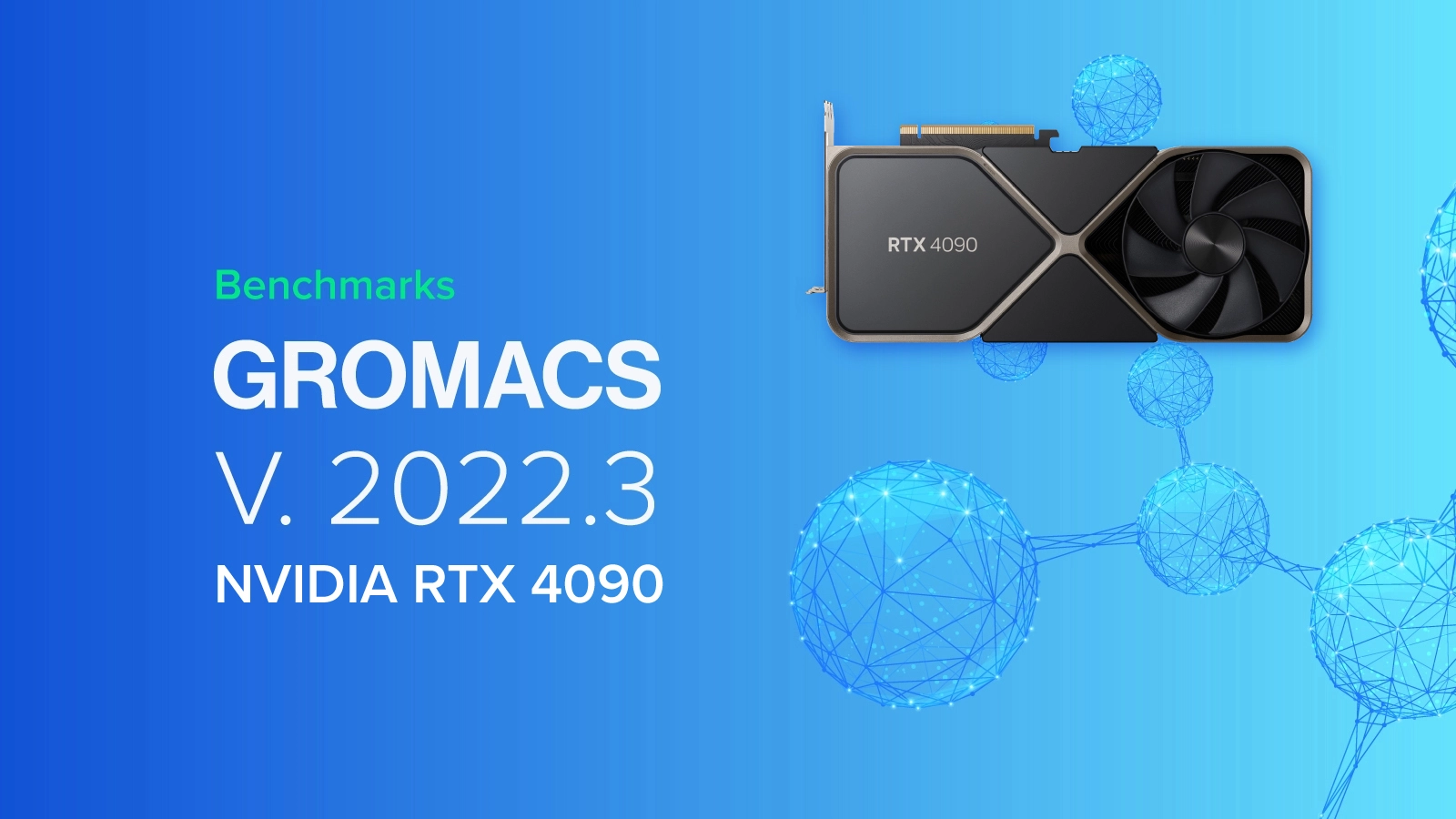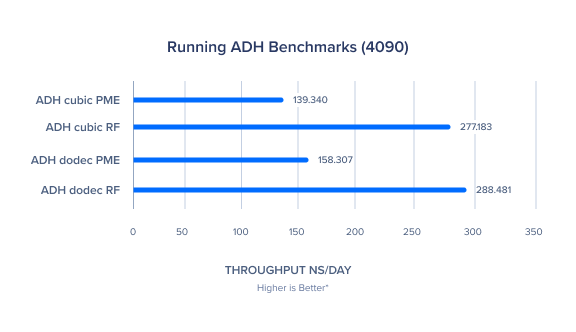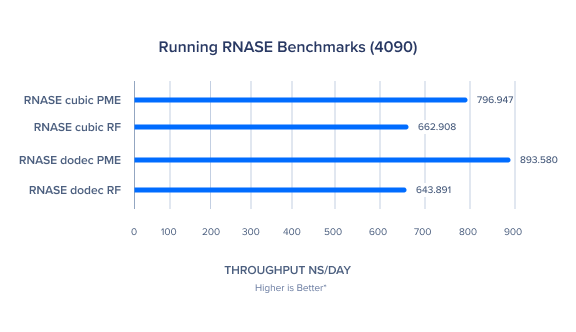
As a value-added supplier of scientific workstations and servers, Exxact regularly provides reference benchmarks in various GPU configurations to guide Molecular Dynamics scientists looking to procure systems optimized for their research. In this blog, we benchmark the NVIDIA RTX 4090 performance using GROMACS MD and evaluate the total nanoseconds of simulation performed per day.
Looking for an HPC workstation or server for molecular dynamics research like drug discovery?
Configure your GROMACS system with our experienced system engineers today!
Software Summary
GROMACS is a powerful open-source molecular dynamics package primarily designed for simulations of proteins, lipids, and nucleic acids, as well as non-biological systems such as polymers. GROMACS supports all the usual algorithms expected from a modern molecular dynamics implementation. GROMACS can be run in parallel in a multi-node environment using the standard MPI communication protocol, and since GROMACS 4.6, has implemented CUDA-based GPU acceleration on NVIDIA GPUs.
GROMACS is known for being extremely user-friendly, with topologies and parameter files written in clear text format. With GROMACS there is a lot of consistency checking, and clear error messages are issued when errors arise.
GPU Summary
The new NVIDIA GeForce RTX 4090 is built on the Ada Lovelace architecture that emphasizes Tensor Cores for HPC acceleration for matrix multiplication. the 4090 has 56% more CUDA cores and has a massive 46% clock speed increase over the last generation 3090 Ti, effectively making this GPU the fastest consumer graphics card you can buy. Let's test the performance in a typical workstation platform used for molecular dynamics simulations:
Exxact Workstation Specification
Processor / Count | 1x AMD Ryzen Threadripper PRO 5995WX |
Graphics Processing Unit | 2x NVIDIA GeForce RTX 4090 |
Memory | 256GB DDR4 Memory |
Storage | 3.84 TB NVMe Drive |
OS | Ubuntu 20.04 |
CUDA Version | 11.8 |
GROMACS Version | 2022.3 |
NVIDIA RTX 4090 Benchmarks in GROMACS Molecular Dynamics
We will be running multiple tests on the same simulation.
- NS/day refers to the number of nanoseconds of simulation that can be performed in a single day; the higher the value, the more time has passed within the simulation, the better.
- The value following GPU designates the GPU ID in the system, [0] represents the first RTX 4090 and [1] represents the second.
- Running Sequential Single GPU tests was better for PME (particle-mesh Ewald) treatments whereas running Sequential Multi GPU tests performed better using RF (reaction field) treatment.
| ADH cubic PME (ns/day) | ADH cubic RF (ns/day) | ADH dodec PME (ns/day) | ADH dodec RF (ns/day) |
|---|---|---|---|---|
Sequential 1x GPU [0] | 139.340 | 216.182 | 157.327 | 233.607 |
Sequential 1x GPU [1] | 138.375 | 213.862 | 158.307 | 241.748 |
Sequential 2x GPU [0, 1] | 106.434 | 277.183 | 84.349 | 288.481 |

| RNASE cubic PME (ns/day) | RNASE cubic RF (ns/day) | RNASE dodec PME (ns/day) | RNASE dodec RF (ns/day) |
|---|---|---|---|---|
Sequential 1x GPU [0] | 798.287 | 561.685 | 893.580 | 564.997 |
Sequential 1x GPU [1] | 796.947 | 553.872 | 875.225 | 552.725 |
Sequential 2x GPU [0, 1] | 361.711 | 662.908 | 379.113 | 643.891 |

Take GROMACS Simulations to the next level with GPUs
CUDA-enabled NVIDIA GPUs get the most out of your MD Simulations. By leveraging the CUDA parallel processing architecture of NVIDIA GPUs, GROMACS CUDA GPU acceleration is now a core part of GROMACS that works in combination with its domain decomposition and load balancing code, delivering massive performance gains when compared to CPU-only processing.
Exxact has teamed up with the GROMACS development team to design a series of GROMACS Servers and Workstations that provide optimum price and performance for a wide range of research applications. These solutions are perfect not only for GROMACS but for other various MD simulation software suites like AMBER, NAMD, Schrodinger, and more.
Build your own professional GPU workstation and accelerate your research exponentially.
Contact Exxact Today to configure yours personally.

GROMACS Benchmark NVIDIA RTX 4090
As a value-added supplier of scientific workstations and servers, Exxact regularly provides reference benchmarks in various GPU configurations to guide Molecular Dynamics scientists looking to procure systems optimized for their research. In this blog, we benchmark the NVIDIA RTX 4090 performance using GROMACS MD and evaluate the total nanoseconds of simulation performed per day.
Looking for an HPC workstation or server for molecular dynamics research like drug discovery?
Configure your GROMACS system with our experienced system engineers today!
Software Summary
GROMACS is a powerful open-source molecular dynamics package primarily designed for simulations of proteins, lipids, and nucleic acids, as well as non-biological systems such as polymers. GROMACS supports all the usual algorithms expected from a modern molecular dynamics implementation. GROMACS can be run in parallel in a multi-node environment using the standard MPI communication protocol, and since GROMACS 4.6, has implemented CUDA-based GPU acceleration on NVIDIA GPUs.
GROMACS is known for being extremely user-friendly, with topologies and parameter files written in clear text format. With GROMACS there is a lot of consistency checking, and clear error messages are issued when errors arise.
GPU Summary
The new NVIDIA GeForce RTX 4090 is built on the Ada Lovelace architecture that emphasizes Tensor Cores for HPC acceleration for matrix multiplication. the 4090 has 56% more CUDA cores and has a massive 46% clock speed increase over the last generation 3090 Ti, effectively making this GPU the fastest consumer graphics card you can buy. Let's test the performance in a typical workstation platform used for molecular dynamics simulations:
Exxact Workstation Specification
Processor / Count | 1x AMD Ryzen Threadripper PRO 5995WX |
Graphics Processing Unit | 2x NVIDIA GeForce RTX 4090 |
Memory | 256GB DDR4 Memory |
Storage | 3.84 TB NVMe Drive |
OS | Ubuntu 20.04 |
CUDA Version | 11.8 |
GROMACS Version | 2022.3 |
NVIDIA RTX 4090 Benchmarks in GROMACS Molecular Dynamics
We will be running multiple tests on the same simulation.
- NS/day refers to the number of nanoseconds of simulation that can be performed in a single day; the higher the value, the more time has passed within the simulation, the better.
- The value following GPU designates the GPU ID in the system, [0] represents the first RTX 4090 and [1] represents the second.
- Running Sequential Single GPU tests was better for PME (particle-mesh Ewald) treatments whereas running Sequential Multi GPU tests performed better using RF (reaction field) treatment.
| ADH cubic PME (ns/day) | ADH cubic RF (ns/day) | ADH dodec PME (ns/day) | ADH dodec RF (ns/day) |
|---|---|---|---|---|
Sequential 1x GPU [0] | 139.340 | 216.182 | 157.327 | 233.607 |
Sequential 1x GPU [1] | 138.375 | 213.862 | 158.307 | 241.748 |
Sequential 2x GPU [0, 1] | 106.434 | 277.183 | 84.349 | 288.481 |

| RNASE cubic PME (ns/day) | RNASE cubic RF (ns/day) | RNASE dodec PME (ns/day) | RNASE dodec RF (ns/day) |
|---|---|---|---|---|
Sequential 1x GPU [0] | 798.287 | 561.685 | 893.580 | 564.997 |
Sequential 1x GPU [1] | 796.947 | 553.872 | 875.225 | 552.725 |
Sequential 2x GPU [0, 1] | 361.711 | 662.908 | 379.113 | 643.891 |

Take GROMACS Simulations to the next level with GPUs
CUDA-enabled NVIDIA GPUs get the most out of your MD Simulations. By leveraging the CUDA parallel processing architecture of NVIDIA GPUs, GROMACS CUDA GPU acceleration is now a core part of GROMACS that works in combination with its domain decomposition and load balancing code, delivering massive performance gains when compared to CPU-only processing.
Exxact has teamed up with the GROMACS development team to design a series of GROMACS Servers and Workstations that provide optimum price and performance for a wide range of research applications. These solutions are perfect not only for GROMACS but for other various MD simulation software suites like AMBER, NAMD, Schrodinger, and more.
Build your own professional GPU workstation and accelerate your research exponentially.
Contact Exxact Today to configure yours personally.
